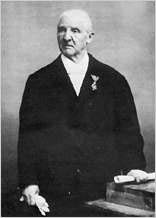Anton Bruckner
Anton Bruckner (1824-1896) was a nineteenth century Austrian composer and hat-maker who grovelled at Wagner's feet and wrote very, very, very long music. He completely lacked musical confidence and didn't know anything about orchestration or harmony, yet kept on writing long after long symphony that no one played. The Schalk Bros. helped him by cleaning up his orchestration, to make his music sound less like Wagner's, but they never inserted any of their own ideas into his music. After his death, some people got the idea that perhaps his original versions might not be as boring as the ones improved on by the Schalks, but figuring out what Bruckner actually wrote and what the Schalks did is tougher than untying the Gordian knot. So there are several different versions of his pieces but they are all just as boring.
Life[edit | edit source]
Bruckner was a quiet, obedient Catholic country boy who really wanted to grow up to be Richard Wagner. There's not much to tell. It may have been that his pastoral surroundings, with their emphasis on constancy and repetitive tasks, such as working in his local Catholic church's priest's bedroom, helped to mold his compositional style. Being a prolific organist, Bruckner was infatuated with dead males. It could be said that all of his symphonies were written for his own darker purposes: to drive his audiences to suicide after transcendentally long periods of repetitive, redundant repetition. He wrote symphonies so that he did not have to pay to watch people commit suicide. Also, he was a necrophiliac.
Composition[edit | edit source]
Bruckner's composition is most saliently characterized by (a) the unprecedented extent of his pretention through bombastic yet uninteresting motivic material mingled among unrelated extraneous naught, (b) an unnecessarily elongated symphonic oeuvre, (c) exceptionally exaggerated repetition by sequences to exacerbate the previously mentioned characteristics.
Bruckner was very skilled at making smooth transitions, with no pause whatsoever between one thematic unit and another, and they blend and follow one into the other with lyrical inevitability. And so, in his sonata form movements, the transition from the heroic first subject group to the lyrical second group is practically imperceptible.
His nearly preposterous pretentiousness through fundamentally powerful yet dry thematic material might induce slumber upon unwary listeners to his music. Furthermore, this oeuvre is notable for its exceptional lengthitude, exacerbated by an enduring devotion to repetition and sequence in all its longest forms, in a form vaguely hinting at protominimalism.
Bruckner's composition is most saliently characterized by (a) the unprecedented extent of his pretention through bombastic yet uninteresting motivic material mingled among unrelated extraneous naught, (b) an unnecessarily elongated symphonic oeuvre, (c) exceptionally exaggerated repetition by sequence to exacerbate the previously mentioned characteristics. However, every now and then in performing a different version of a particular symphony, after hearing all the familiar repetitions, something happens that is quite different from what has gone on before and almost sounds out of place. But one can safely go back to sleep when this sidetrack leads back to the same old and worn path.
A suggestion that public hearings on applications be limited to one every six months was taken under advisement by the committee. Future plans will, of necessity, have great bearing on the situation as it now stands. Decisions will have to be made of the actual planning of the project will take considerable time but it is felt that these steps are very important. Bruckner was very skilled at making smooth transitions, with no pause whatsoever between one thematic unit and another, and they blend and follow one into the other with lyrical inevitability.
The slow movements of his symphonies are so slow and exhausting that they can't be included in relaxing Adagio compilations, while his minuets are completely unsuitable music to dance to. In the finale he knows what the end is (the same melody from the first movement repeated exactly the same way, but in a major key by the whole orchestra) but he has no idea how to get there. This is the reason his finales are more revised than his other movements.
Works[edit | edit source]
Symphonies[edit | edit source]
- Symphony no. 00 "Betcha you didn't see that coming!"
- Symphony no. 0
- Symphony no. 1
- Symphony no. 2
- Symphony no. 3, "The Wagner Fan Club"
- Original 1873 version
- 1876 version. Due to Richard Wagner's modesty, Bruckner removes all Wagner quotations except a couple to Die Walküre
- 1878 version, two Wagner quotations deleted from the 1876 version are restored
- 1889 version
- Symphony no. 4 "The Hunt"
- Original 1874 version
- 1878 version, boring scherzo discarded, more virtuosic finale added
- 1880 version, some parallel fifths rewritten
- 1888 version, yet another new finale and it's still not good enough
- Gustav Mahler's reorchestration, in which he adds eight motor-horns in B-flat, four motor-tubas in E-flat, two tromboons, a cowbell choir, a triple bass drum, rattles, bird whistles, guitars, mandolins, banjos, ukuleles, lasso d'amore, etc.
- Symphony no. 5 "The Pedantic"
- Symphony no. 6
- Symphohy no. 7
- Symphony no. 8 "The Antagonistic"
- Symphony no. 9 "The Unfini.."
Choral Works[edit | edit source]
- Te Deum (literally "The Doom") for apocalyptic horsemen quartet
- Mass no. 1 "Look ma! I wrote a mass"
- Mass no. 2 "Now I'm twice the catholic"
- Mass no. 3 "Here's another one, why not"
- Mass no. 4 "Hey Mr. Pope man, can I have a cookie"
- Mass no. 5 "The result of fifty-eight consecutive sunday afternoons with nothing to do"
- Mass no. 6 "I'd better be safe"
. . . etc. . . .
- Mass no. n "Make me the Pope now" (for very large n)

